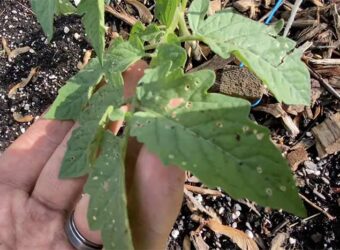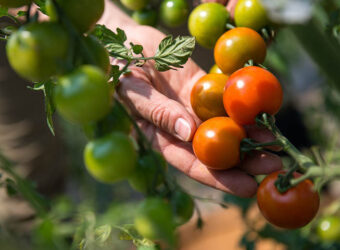Strawberries are a great choice for beginners as they are relatively easy to grow, and homegrown strawberries are much sweeter and juicier than those found in grocery stores.
Strawberries are most flavorful when harvested at full ripeness. I personally love strawberries and always have a full raised bed of them in my small garden. This article will share with you how to harvest strawberries at the right time, with no-nonsense!
How Do I Know If Strawberries Are Ripe?
Strawberries are typically ready for harvesting 4 to 6 weeks after blossoming. One of the common concerns of beginners when growing strawberries is they don’t know which strawberries are fully ripe.
Here’s what you should look for:
- Color – Strawberries are ripe when they are fully red. If any part of the fruit still shows white, green, or yellow, it is not fully ripe yet.
- Texture – The texture of the strawberry can also give you a clue about its ripeness. A ripe strawberry should be firm but slightly soft to the touch. If it is too hard, it is not ready to be picked. On the other hand, if it is too soft or mushy, it may be overripe.
- Try it! – Why not pick one that you think is fully ripe and see how it tastes? If it tastes great, then you will know exactly what berry to look for next time!
How to Harvest Strawberries?
One of the things I love about growing my own strawberries is being able to pick the fruit at the peak of its ripeness and eat them right away, as they will not ripen further once they are off the plant, and the sugar in berries converts to starch soon after they’re picked.
Here’s how I pick my strawberries:
- Harvest in the early morning when the berries are cool if you want to eat them right away. If you want to store them, pick fruits in the warmth of the afternoon for maximum flavor.
- Harvest only fully red (ripe) berries to ensure optimal flavor and sugar levels. Berries still showing white anywhere on the berry, including the shoulders, should be left for the next picking.
- Harvest every two to three days to prevent fruits from overripening and rot.
- Use your two hands or pruners to snip off the stem about half-inch above the fruit, leaving part of the stem and the cap attached to the berry. Do not pull the berry, as this can damage the plant.
How To Store Strawberries Properly After Harvest?
After harvesting your strawberries, it’s important to store them properly to maintain their freshness and flavor.
Here are some steps that I did myself right after harvesting strawberries:
- Sort and Remove Bruised Berries: Before storing your strawberries, sort through them and remove any bruised or damaged berries. These berries can cause the others to spoil more quickly.
- Don’t Wash Until Ready to Use: It’s best to not wash your strawberries until you’re ready to use them. Moisture can cause them to spoil more quickly, so it’s best to keep them as dry as possible until you’re ready to eat them.
- Store in the Refrigerator: Strawberries should be stored in the refrigerator immediately after harvest to keep them fresh. Place them in a container or on a plate lined with paper towels to absorb any excess moisture. You can also cover them with plastic wrap or a lid to keep them from drying out.
- Use Within a Few Days: Strawberries are best when eaten within a few days of harvesting. If you need to store them for longer, consider freezing them.
Tips on Maximum Your Strawberries Harvesting!
- Choose the right variety: Select a strawberry variety that is well-suited to your climate and soil conditions. Consider factors such as day length, temperature, and disease resistance when choosing a variety. For home gardeners, I recommend June-bearers, although you will have to wait a year for fruit harvesting, it will be well worth it.
- Plant in the right location: Ensure that your strawberry plants receive at least 6-8 hours of sunlight per day and are planted in well-draining soil. Consider using raised beds or containers to improve drainage.
- Provide adequate water: Strawberries require consistent moisture, especially during the flowering and fruiting stages. Water deeply and regularly, and consider using a drip irrigation system to ensure even moisture distribution.
- Fertilize appropriately: Use a balanced fertilizer to provide the necessary nutrients for strawberry plants. Once strawberries flower, fertilize them with a high-potassium, liquid fertilizer to encourage good fruit production. Avoid over-fertilizing, as this can lead to excessive leaf growth at the expense of fruit production.
- Control pests and diseases: Monitor your plants regularly for signs of pests and diseases, and take appropriate measures to control them. Consider using natural predators, organic sprays, or cultural practices to manage pests and diseases.
- Mulch: Apply a layer of mulch around your strawberry plants to help retain moisture, suppress weeds, and protect the fruits from coming into contact with the soil.
- Prune and thin: In the first year, pick off blossoms to discourage strawberry plants from fruiting, and focus their energy to build good roots and leaves, this will help the yield much better in the next year. Regularly remove old or diseased leaves, as well as runners, to promote air circulation and reduce the risk of disease. Thin out excess fruit to allow the remaining berries to reach their full size.
- Harvest at the right time: Pick strawberries when they are fully ripe to maximize flavor and sweetness. Be gentle when harvesting to avoid damaging the fruit and plants.
- Renew plants: After a few years, consider replacing your strawberry plants with new ones to maintain high productivity.
That’s it for everything you need to know about harvesting strawberries. Happy picking!






